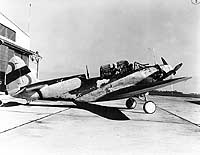
In mid-1940, the Navy tested a number of aircraft camouflage schemes designed by the noted artist and Naval Reserve officer McClelland Barclay. Some of these designs were applied to TBD-1 torpedo planes of at least two squadrons, VT-3 and VT-5, and were tested during fleet exercises held at that time. These tests had no lasting effect on U.S. Navy aircraft markings, except, perhaps, to persuade Naval Aviators that disruptive camouflage schemes had little use on planes intended for employment at sea.
This page features all our views of Douglas TBD-1 torpedo planes wearing experimental camouflage schemes tested in 1940.
For other photographs of Navy planes painted in 1940 experimental camouflage, see:
For additional views of TBD-1 aircraft, see:
| If you want higher resolution reproductions than the digital images presented here, see: "How to Obtain Photographic Reproductions." |
Click on the small photograph to prompt a larger view of the same image.
|
Photo #: NH 96161 Douglas TBD-1 torpedo Plane (Bureau # 0320), of Torpedo Squadron Three (VT-3) At Naval Air Station, North Island, California, 22 August 1940. It is painted in McClelland Barclay experimental camouflage design number 7. This aircraft was lost at the Battle of the Coral Sea in May 1942, while serving with Torpedo Squadron Two on USS Lexington (CV-2). U.S. Naval History and Heritage Command Photograph. Online Image: 58KB; 740 x 605 pixels |
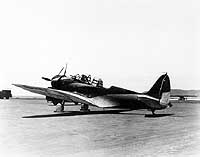 |
|
Photo #: NH 96162 Douglas TBD-1 torpedo Plane (Bureau # 0320), of Torpedo Squadron Three (VT-3) At Naval Air Station, North Island, California, 22 August 1940. It is painted in McClelland Barclay experimental camouflage design number 7. This aircraft was lost at the Battle of the Coral Sea in May 1942, while serving with Torpedo Squadron Two on USS Lexington (CV-2). U.S. Naval History and Heritage Command Photograph. Online Image: 68KB; 740 x 565 pixels |
 |
|
Photo #: NH 96163 Douglas TBD-1 torpedo Plane (Bureau # 0320), of Torpedo Squadron Three (VT-3) At Naval Air Station, North Island, California, 22 August 1940. It is painted in McClelland Barclay experimental camouflage design number 7. This aircraft was lost at the Battle of the Coral Sea in May 1942, while serving with Torpedo Squadron Two on USS Lexington (CV-2). U.S. Naval History and Heritage Command Photograph. Online Image: 61KB; 740 x 600 pixels |
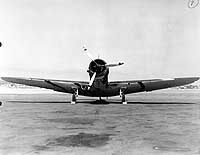 |
|
Photo #: NH 96164 Douglas TBD-1 torpedo Plane (Bureau # 0339), of Torpedo Squadron Three (VT-3) At Naval Air Station, North Island, California, 22 August 1940. It is painted in McClelland Barclay experimental camouflage design number 8. Note .30 caliber machinegun in the plane's after cockpit. Original side markings, "3-T-?" can be faintly seen on the after fuselage through the badly weathered paint job. This aircraft was lost at the Battle of the Coral Sea in May 1942, while serving with Torpedo Squadron Two on USS Lexington (CV-2). U.S. Naval History and Heritage Command Photograph. Online Image: 87KB; 740 x 600 pixels |
 |
|
Photo #: NH 96165 Douglas TBD-1 torpedo Plane (Bureau # 0339), of Torpedo Squadron Three (VT-3) At Naval Air Station, North Island, California, 22 August 1940. It is painted in McClelland Barclay experimental camouflage design number 8. Note .30 caliber machinegun in the plane's after cockpit. Uncamouflaged VT-3 TBD-1s are in the background. This aircraft was lost at the Battle of the Coral Sea in May 1942, while serving with Torpedo Squadron Two on USS Lexington (CV-2). U.S. Naval History and Heritage Command Photograph. Online Image: 69KB; 740 x 600 pixels |
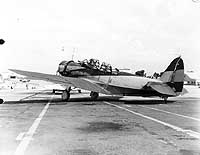 |
|
Photo #: NH 96166 Douglas TBD-1 torpedo Plane (Bureau # 0339), of Torpedo Squadron Three (VT-3) At Naval Air Station, North Island, California, 22 August 1940. It is painted in McClelland Barclay experimental camouflage design number 8. This aircraft was lost at the Battle of the Coral Sea in May 1942, while serving with Torpedo Squadron Two on USS Lexington (CV-2). U.S. Naval History and Heritage Command Photograph. Online Image: 84KB; 740 x 605 pixels |
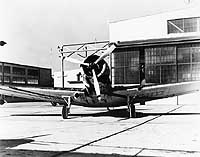 |
|
Photo #: NH 95314 Douglas TBD-1 Torpedo Planes, of Torpedo Squadron Five (VT-5) Parked on the after flight deck of USS Yorktown (CV-5) at Naval Air Station, North Island, San Diego, California, in June 1940. Three of these aircraft are painted in an experimental color scheme used during Fleet Problem XXI. This section of the ship was examined when Yorktown's wreck was located in May 1998. The after thirty feet (approximately) of the flight deck was missing, but most other features seen were present, including the ship's name on her stern. This view is cropped from Photo # 80-G-652042. U.S. Naval History and Heritage Command Photograph. Online Image: 130KB; 740 x 605 pixels |
 |
For other photographs of Navy planes painted in 1940 experimental camouflage, see:
For additional views of TBD-1 aircraft, see:
NOTES:
| If you want higher resolution reproductions than the digital images presented here, see: "How to Obtain Photographic Reproductions." |
Page made 14 February 2001
Coding updated 7 May 2009